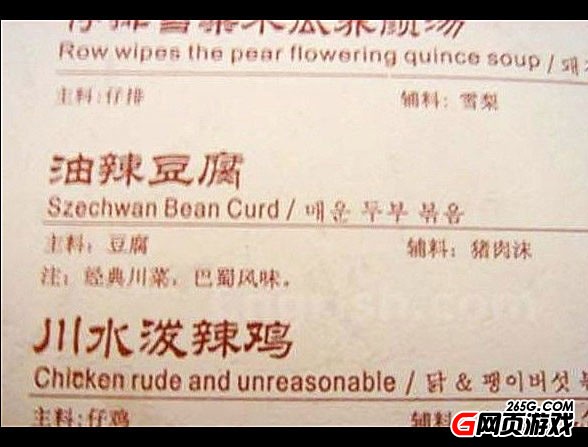Rude and unreasonable chicken
« previous post | next post »
From June Teufel Dreyer:
This one has been circulating for several years, but I don't think I've ever gotten around to writing about it yet.
Chuānshuǐ pōlà jī 川水泼辣鸡 ("Sichuanese spicy chicken")
Google Translate offers the following renderings of "pōlà 泼辣": "pungent; forceful; bold and vigorous; shrewish; rude and unreasonable; daring and resolute".
Baidu Fanyi gives: "forceful; shrewish; rude and unreasonable; vixenish; fierce and unreasonable".
Bing Translator has only "provocative".
Perhaps a translation like "fiery" would suffice both for the Sichuanese chicken dish and for the temperament it designates.
Here's a rather lame attempt to justify applying the adjective to this particular dish:
"The pitfalls of translation", Cultural Intelligence (11/27/13).
[Thanks to Tao Tang and Qing Liao]

Vicki Rosenzweig said,
December 30, 2018 @ 8:42 am
what I'm curious about is the quince soup.
Rachael Churchill said,
December 30, 2018 @ 11:53 am
Well, English has "jerk chicken"…
hwu said,
December 30, 2018 @ 6:45 pm
What about the Korean translation? Sorry I don't speak Korean, but that & mark seems so strange…
B.Ma said,
December 31, 2018 @ 5:14 am
@Vicki Rosenzweig
My best guess for the row that was cut off is 仔排雪梨木瓜养颜汤 ribs, pear and papaya beautifying soup, i.e. it's supposed to keep you healthy and looking pretty.
According to Wikipedia, 木梨 is another name for quince (I can't say I am familiar with quinces in English or Chinese) so at a stretch, the translator parsed 梨木 as 木梨?? But it correctly identified 雪梨 as pear.
@hwu
I don't speak Korean either but it says 닭 & 팽이버섯 chicken and enokitake. On the face of it the ampersand is simply used as its regular meaning of "and", but no idea where the mushroom comes from – I don't think it's a typical ingredient of this dish
Victor Mair said,
December 31, 2018 @ 9:48 am
@B. Ma
Excellent decipherment! My students and I had come to the same conclusion yesterday but I didn't have a chance to post it till now because of the holiday festivities.
In keeping with Language Log practice, I provide here the Hanyu Pinyin Romanization, transcription, and translation of the name of the dish in Chinese, with a couple of notes:
=====
zǐpái 仔排* pork ribs; baby back ribs
xuělí 雪梨 snow pear / Pyrus nivalis
mùguā 木瓜 papaya
yǎngyán 养颜 nourish the complexion (i.e., facial skin); beauty, as in "beauty soup"
tāng 汤 soup
—–
*The first character means "young; minute; son; whelp; young animal". The second character means "arrange; eject; exclude; put in order; row; ribs", etc.
—–
Together it means:
Zǐpái xuělí mùguā yǎngyán tāng
仔排雪梨木瓜养颜汤
"Beautifying snow pear and papaya soup with baby back ribs"
=====
So now, although the photograph at the top of o.p. has been circulating on the internet for years, leaving countless souls befuddled by the English name of the first dish pictured, viz., "Row wipes the pear flowering quince soup", and its corresponding decapitated row of Chinese characters, we now have the first convincing explanation of how it came about.
BZ said,
December 31, 2018 @ 11:48 am
And here I thought it was one of those F Words on menus where someone censored it after the fact.
John Rohsenow said,
December 31, 2018 @ 12:19 pm
Could it be that the translator does know what s/he is doing, but just has an off-beat sense of humor when choosing among the assisted translation alternatives.? ;-)
hwu said,
December 31, 2018 @ 1:13 pm
@B.Ma
Do you know a dish called "Braised Chicken and Rice/黄焖鸡米饭" which is currently very popular in China? Enokitake is a common ingredient of this dish, however I am also not sure whether people use it in "Sichuanese spicy chicken/川水泼辣鸡".
Rui said,
January 5, 2019 @ 11:04 pm
Here "川水" means "sichuanese oil", this oil is made by frying chili pepper and other spices in it.
So "川水泼辣鸡" = "油泼辣子鸡", here "泼" is a verb and "辣子鸡" is a noun. "辣子鸡" is a popular dish among many areas, having many versions, like "干锅辣子鸡,黄焖辣子鸡,家常辣子鸡".
"油泼" means to pour hot boiling spicy oil on the cooked meat, and this is the last step of the process..
Victor Mair said,
January 6, 2019 @ 10:25 am
It's curious that, when I enter 川水 into Google, there are more than a million results, but — of the hundreds I looked at — they all had to do with Japan, where the term is pronounced "kawamizu".
I noticed this when I was preparing this post in late December, but didn't know what to make of it in terms of the dish being discussed here.